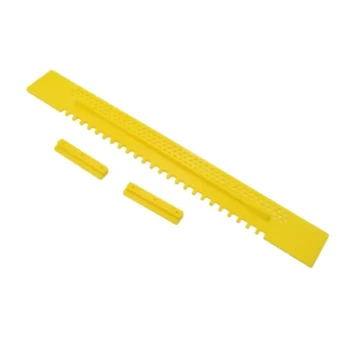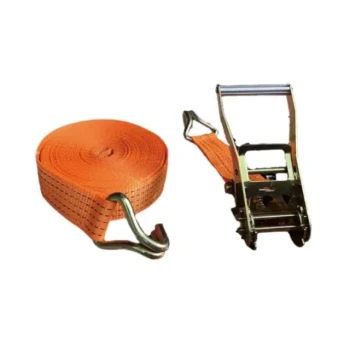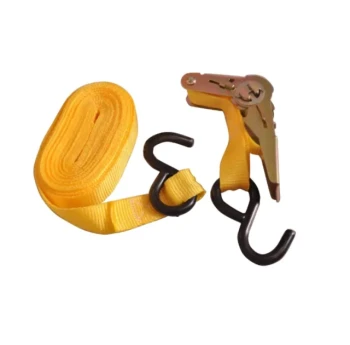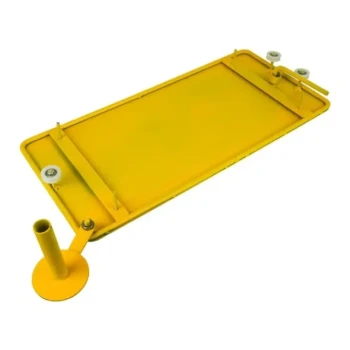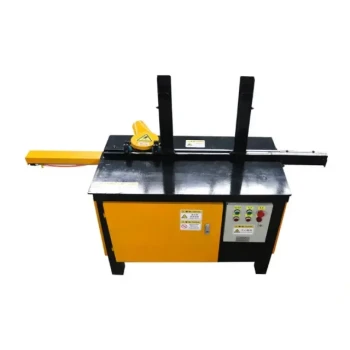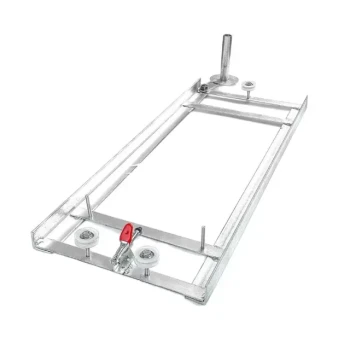From a purely operational standpoint, the Langstroth hive is the most common and standardized choice for beekeepers. Its system of movable frames has become the industry benchmark for hive inspections and honey extraction, making it the default recommendation for many beginners.
The concept of a single "best" beehive is a myth. The ideal hive is not a universal design, but rather the one that best aligns with your specific goals, physical abilities, and beekeeping philosophy.
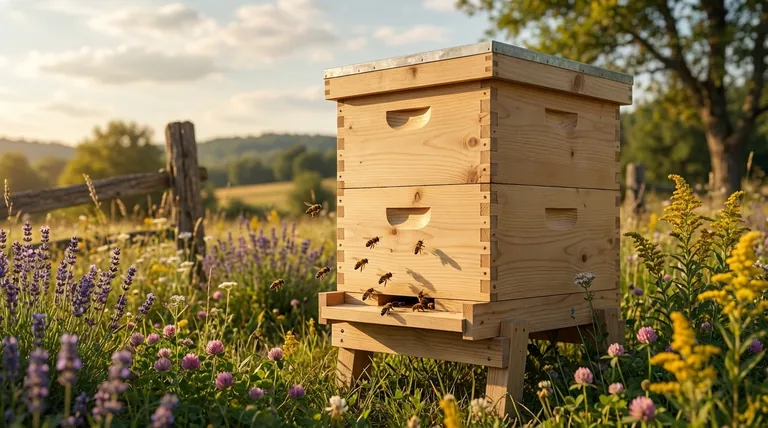
Deconstructing the "Best" Hive: Key Factors to Consider
Choosing a hive is the first major decision in a beekeeper's journey. Your choice will influence everything from how you inspect your bees to how you harvest honey. The "best" hive is the one that best fits you.
Ease of Management and Inspection
The ability to easily open the hive and inspect the brood (baby bees) and food stores is critical for colony health. This is where the Langstroth design, with its individually removable frames, truly excels.
Other hive types that use "top bars" without full frames can make inspections more delicate, as the comb is more fragile and not supported on all four sides.
Goal: Honey Production vs. Natural Beekeeping
Are you aiming to maximize your honey harvest, or are you more interested in supporting pollinators with minimal intervention?
Langstroth hives are designed for production efficiency. Their uniform, rectangular frames are made to fit perfectly into honey extractors. Hives like the Top Bar or Warre are considered more "bee-centric," allowing bees to build comb in more natural, catenary curves.
Physical Requirements and Weight
This is a non-negotiable factor for many people. A standard Langstroth "honey super" (a box full of honey) can weigh between 50 and 80 pounds (22-36 kg). Managing a hive may require lifting several of these.
In contrast, hives like the horizontal Top Bar require you to lift only one comb at a time, which weighs just a few pounds.
Standardization and Equipment Availability
Because the Langstroth is the dominant design, its components are standardized and widely available from nearly every beekeeping supplier. You can easily buy new boxes, frames, and tools that are guaranteed to fit.
Other hive designs are less common. This may mean you have fewer choices for suppliers, or you might need to build components yourself.
Comparing the Three Main Hive Types
While many designs exist, most beginners will choose between the Langstroth, the Top Bar, and the Warre hive.
The Langstroth Hive: The Industry Standard
This is the familiar stack of white boxes seen in fields everywhere. It consists of a bottom board, a deep box for the brood chamber, and shallower boxes (supers) stacked on top for honey storage.
Its primary advantage is the movable frame, which allows for thorough inspections and easy honey extraction. It is highly modular and expandable.
The Top Bar Hive (TBH): The Naturalist's Choice
A Top Bar hive is a single, long box with simple wooden bars laid across the top. Bees build their comb down from these bars naturally, without pre-made foundation.
Because it is horizontal, there is no heavy lifting of stacked boxes. You inspect the colony by moving bars one by one from the front to the back. It is simple in design and promotes natural bee behavior.
The Warre Hive: The Vertical Top Bar
The Warre hive attempts to blend the natural comb of a TBH with the vertical, space-saving design of a Langstroth. It is a stack of smaller, square boxes that all use top bars instead of frames.
The key difference in management is that new boxes are typically added to the bottom of the stack, a process called "nadiring." This more closely mimics how bees extend their nest downwards in a hollow tree.
Understanding the Trade-offs
Every hive design is a compromise. Being aware of these trade-offs is the key to avoiding frustration later.
The Weight vs. Yield Dilemma
The Langstroth hive is unmatched for producing large quantities of honey that can be easily extracted. This efficiency comes at the cost of very heavy lifting.
The Top Bar hive solves the weight problem completely, but its honey yield is generally lower, and harvesting involves crushing and straining the comb rather than spinning it in an extractor.
Movable Frames vs. Natural Comb
The rigid frames of a Langstroth make the hive incredibly durable and easy to work with. You can handle them roughly, and they are designed for mechanical extraction.
Letting bees build their own natural comb, as in a Top Bar or Warre, is often considered healthier for the colony. However, these foundationless combs are far more fragile and must be handled with care to prevent them from breaking.
Standardization vs. Simplicity
With a Langstroth hive, you never have to worry about finding compatible parts. This is a massive advantage, especially when you need equipment quickly.
The simplicity of a Top Bar hive is its main appeal. It can be built with basic woodworking skills from a simple set of plans, freeing you from relying on commercial suppliers.
Making the Right Choice for Your Goals
Filter your decision through your personal context. There is no wrong answer, only the answer that is right for you.
- If your primary focus is maximizing honey production and following standard practices: The Langstroth hive is your most direct path to success, with a wealth of information available.
- If your primary focus is minimizing heavy lifting and a more natural approach: The horizontal Top Bar hive is an excellent choice, especially for backyard beekeepers.
- If you want a balance of natural comb, vertical expansion, and less disruptive management: The Warre hive offers a compelling middle ground that mimics a natural bee nest.
Ultimately, the best hive is the one that keeps you engaged and excited about the craft of beekeeping.
Summary Table:
| Hive Type | Best For | Key Feature | Key Limitation |
|---|---|---|---|
| Langstroth | Maximizing honey production, standard practices | Movable frames for easy inspection & extraction | Heavy lifting (50-80 lbs per box) |
| Top Bar | Natural beekeeping, minimizing heavy lifting | Lightweight, single-comb inspections | Lower honey yield, fragile natural comb |
| Warre | Natural comb with vertical expansion | Nadiring (adding boxes to bottom) mimics natural nest | Less common, fewer standardized parts |
Ready to Equip Your Apiary with the Right Hive?
Choosing the right hive is just the first step. HONESTBEE supplies the durable, high-quality beekeeping supplies and equipment that commercial apiaries and distributors need to succeed.
- For Langstroth Hives: We offer standardized, interchangeable components for maximum efficiency.
- For Alternative Hives: We provide quality materials and foundational equipment to support your beekeeping philosophy.
Let us help you build a stronger, more productive operation. Contact HONESTBEE today to discuss your wholesale needs and get the right equipment for your goals.
Visual Guide
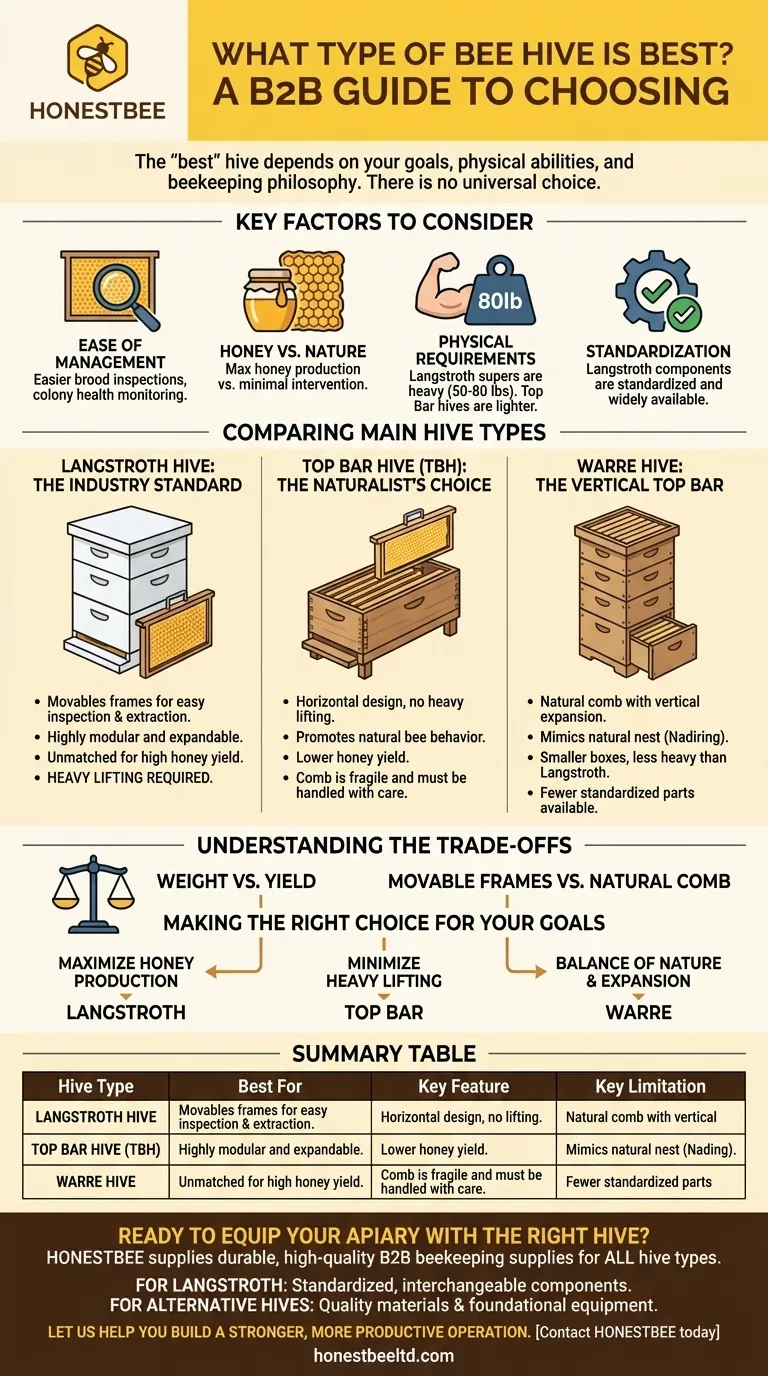
Related Products
- Langstroth Honey Bee Box Hive Boxes for Different Depths
- Professional Galvanized Hive Strap with Secure Locking Buckle for Beekeeping
- Professional Reversible Beehive Hive Entrance
- Heavy Duty Ratchet Hive Strap
- Heavy-Duty Nylon Beehive Hive Strap with Stainless Steel Cinch Buckle
People Also Ask
- What are the sizes available for Langstroth boxes? A Guide to 8-Frame vs. 10-Frame & Depths
- What is the best time to inspect a hive? Optimize for Bee and Beekeeper Safety
- How does a hive box work? A Guide to the Langstroth Hive System for Beekeepers
- What is the purpose of the boxes in a Langstroth hive? A Guide to Modular Beekeeping Success
- How deep is a medium bee box? Unlock the Key to a Versatile and Manageable Hive


